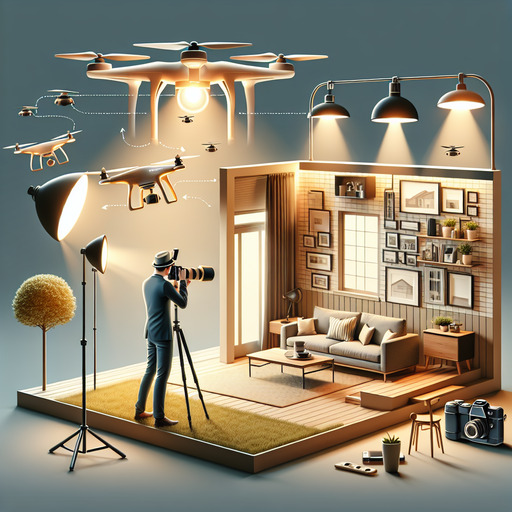
-
Table of Contents
- Mastering Real Estate Photography: Tips, Techniques, and Tools
- Understanding the Importance of Real Estate Photography
- The Impact of Quality Photos on Property Listings
- Essential Real Estate Photography Tips
- 1. Use the Right Equipment
- 2. Master the Art of Lighting
- 3. Pay Attention to Composition
- Advanced Techniques: Real Estate Drone Photography
- Benefits of Drone Photography
- Editing Your Real Estate Photos
- Key Editing Techniques
- Pricing Your Real Estate Photography Services
- Factors Influencing Pricing
- Conclusion
- Questions and Answers
- 1. What is the best time of day for real estate photography?
- 2. How can I improve my real estate photos without professional equipment?
- 3. Is drone photography necessary for all real estate listings?
Mastering Real Estate Photography: Tips, Techniques, and Tools
In the competitive world of real estate, first impressions are everything. High-quality real estate photography can make or break a property listing, influencing potential buyers’ decisions before they even step foot inside. Whether you’re a seasoned photographer or a real estate agent looking to enhance your listings, understanding the nuances of real estate photography is crucial. This guide will walk you through essential tips, techniques, and tools to elevate your property photography game.
Understanding the Importance of Real Estate Photography
Real estate photography is more than just snapping pictures of a property. It’s about capturing the essence and potential of a space, enticing buyers to envision themselves living there. According to the National Association of Realtors, 87% of home buyers found photos to be the most useful feature when searching for a home online.
The Impact of Quality Photos on Property Listings
- Properties with high-quality images sell 32% faster than those with lower-quality visuals.
- Listings with professional photos receive 118% more online views.
- Homes with more photos sell for more money, with an average increase of $3,000 to $11,000.
Essential Real Estate Photography Tips
To capture stunning real estate photos, you need more than just a good camera. Here are some practical tips to get you started:
1. Use the Right Equipment
Investing in the right real estate photography equipment is crucial. A DSLR camera with a wide-angle lens is ideal for capturing spacious interiors. Consider using a tripod for stability and consistency in your shots.
2. Master the Art of Lighting
Lighting can make or break a photo. Natural light is your best friend, so schedule shoots during the day when the light is soft and even. Use additional lighting equipment if necessary to eliminate shadows and highlight key features.
3. Pay Attention to Composition
Composition is key in real estate photography. Use the rule of thirds to create balanced and visually appealing images. Ensure that lines are straight and avoid clutter in your shots to maintain focus on the property.
Advanced Techniques: Real Estate Drone Photography
Drone photography offers a unique perspective, showcasing properties from angles that traditional photography cannot. This technique is particularly useful for large estates or properties with stunning landscapes.
Benefits of Drone Photography
- Provides a comprehensive view of the property and its surroundings.
- Highlights features like pools, gardens, and nearby amenities.
- Creates a sense of scale and grandeur.
Editing Your Real Estate Photos
Post-processing is an essential step in real estate photography. Editing can enhance colors, correct lighting issues, and remove unwanted elements. Software like Adobe Lightroom and Photoshop are popular choices among photographers.
Key Editing Techniques
- Adjust brightness and contrast to make images pop.
- Use HDR (High Dynamic Range) to balance exposure in challenging lighting conditions.
- Correct lens distortion to ensure straight lines and accurate proportions.
Pricing Your Real Estate Photography Services
Determining real estate photography pricing can be challenging. Consider factors like the size of the property, the number of photos required, and any additional services like drone photography or virtual tours.
Factors Influencing Pricing
- Location and market demand.
- Experience and expertise of the photographer.
- Turnaround time and editing requirements.
Conclusion
Real estate photography is a powerful tool in the property market. By mastering the right techniques and investing in quality equipment, you can create compelling images that captivate potential buyers. Whether you’re a photographer or a real estate professional, these insights will help you enhance your listings and achieve better results.
For more information on the impact of real estate photography, visit this Wikipedia page.
Questions and Answers
1. What is the best time of day for real estate photography?
The best time for real estate photography is during the day when natural light is abundant. Early morning or late afternoon provides soft, even lighting that enhances the property’s features.
2. How can I improve my real estate photos without professional equipment?
Even without professional equipment, you can improve your photos by focusing on composition, using natural light, and ensuring the property is clean and decluttered. Editing software can also enhance your images.
3. Is drone photography necessary for all real estate listings?
Drone photography is not necessary for all listings but can be beneficial for large properties or those with unique features. It provides a comprehensive view that traditional photography cannot offer.
If you’re interested in learning more about our real estate photography services or have any questions, please reach out to us via our contact page.